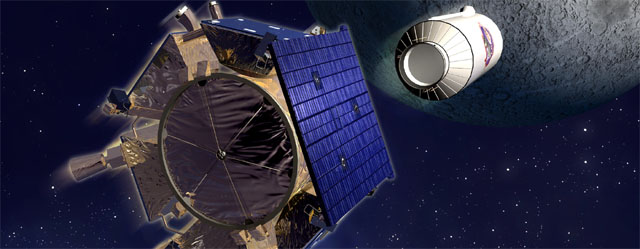NASA Finds Ice Crystals on the Moon
Nearly a year after announcing the discovery of water molecules on the moon, scientists Thursday revealed new data uncovered by NASA’s Lunar CRater Observation and Sensing Satellite (LCROSS) and Lunar Reconnaissance Orbiter (LRO).
The missions found evidence that the lunar soil within shadowy craters is rich in useful materials, and the moon is chemically active and has a water cycle.
Scientists also confirmed the water was in the form of mostly pure ice crystals in some places. The results are featured in six papers published in the Oct. 22 issue of Science.
Also Read:
NASA Invites Students for Great Moonbuggy Race
Space Surveillance Satellite Ready for Launch
Now a Science Social Network for Kids
Discovery Award for Top Young Scientist
“NASA has convincingly confirmed the presence of water ice and characterized its patchy distribution in permanently shadowed regions of the moon,” said Michael Wargo, chief lunar scientist at NASA Headquarters in Washington.
“This major undertaking is the one of many steps NASA has taken to better understand our solar system, its resources, and its origin, evolution, and future.”
The twin impacts of LCROSS and a companion rocket stage in the moon’s Cabeus crater on Oct. 9, 2009, lifted a plume of material that might not have seen direct sunlight for billions of years.
As the plume traveled nearly 10 miles above the rim of Cabeus, instruments aboard LCROSS and LRO made observations of the crater and debris and vapor clouds. After the impacts, grains of mostly pure water ice were lofted into the sunlight in the vacuum of space, reports NASA.
“Seeing mostly pure water ice grains in the plume means water ice was somehow delivered to the moon in the past, or chemical processes have been causing ice to accumulate in large quantities,” said Anthony Colaprete, LCROSS project scientist and principal investigator at NASA’s Ames Research Center in Moffett Field, Calif.
“Also, the diversity and abundance of certain materials called volatiles in the plume, suggest a variety of sources, like comets and asteroids, and an active water cycle within the lunar shadows.”
Advertisements:
Business Proposal
Digital Media Campaigns
The instruments also discovered relatively large amounts of light metals such as sodium, mercury and possibly even silver.
By understanding the processes and environments that determine where water ice will be, how water was delivered to the moon and its active water cycle, future mission planners might be better able to determine which locations will have easily-accessible water.
The existence of mostly pure water ice could mean future human explorers won’t have to retrieve the water out of the soil in order to use it for valuable life support resources.
In addition, an abundant presence of hydrogen gas, ammonia and methane could be exploited to produce fuel.
Photo courtesy: NASA






